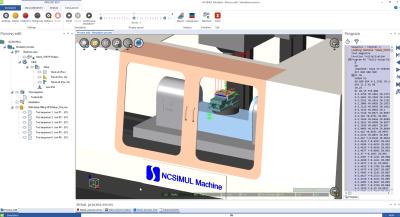
The new version of SURFCAM Traditional computer-aided-manufacturing (CAM) software offers a direct connection to the NCSIMUL machining simulation solution by Hexagon Manufacturing Intelligence, a development that provides SURFCAM programmers with greater control over the manufacturing process by delivering a more accurate and detailed picture of each machining operation from start to finish.
SURFCAM Traditional is designed to provide manufacturers with robust, flexible, and easy-to-use programming capabilities for 2-5-axis machining, in addition to turning and wire-EDM programming functions. NCSIMUL machining-simulation software can be used in conjunction with a wide range of CAM systems to verify and optimize toolpath, quickly switch NC programs between machine tools, and simulate machining operations.
By using a direct link to NCSIMUL from within the SURFCAM Traditional 2021 interface, SURFCAM users will have access to true G-code toolpath verification, editing and simulation functions to ensure that their NC programs are collision free and reflect the full CNC machining environment. This new associativity between the two systems also enables users to compare cut stock with original design geometry.
The ability to view the state of the stock model throughout the machining process, including multiple operation parts or multiple part setup, provides machinists with the flexibility needed to adjust operations when required to prevent errors.
“Creating a digital thread that connects the virtual with the real ensures that manufacturers can achieve greater productivity without sacrificing quality because they’re looking at accurate data throughout the entire manufacturing process,” said Machining Market and Product Manager Miguel Johann of Hexagon Manufacturing Intelligence.
“By using SURFCAM Traditional and NCSIMUL in tandem, users can pass the toolpath generated in SURFCAM — along with the part, fixture, and stock geometry — to NCSIMUL for G-code validation, toolpath verification, and a more detailed view of all operations.”
SURFCAM Traditional users can access NCSIMUL via the system’s operations manager, which lists set-ups for operations in the order they’ll be performed, as well as relevant machining data for each operation. From there, users can view the part within the NCSIMUL interface in various modes, including wireframe, facet, shading and shape modes. Tooling, tooling sequences, and toolpath can be viewed and edited within that same interface.
The direct link to NCSIMUL also enables users to digitally add or subtract part stock, and adjust fixturing, clamps, and cutting-tool libraries. Access to detailed virtual set-ups remove guesswork by providing accurate digital twins of complete machining environments that can then be recreated in the real world.
“This version of SURFCAM Traditional is focused on our core users’ needs for general and advanced usage,” Johann said. “From beginner to expert, we are working to advance customer experience and usability.”
Additional enhancements available with the latest version of SURFCAM Traditional include the option for layer-based fixturing, which allows users to draw or import fixture geometry directly into the software instead of entering fixturing data numerically or via an external file.
With the new layering option, fixturing data resides on a set of layers defined by users, and the fixturing information is referenced during the toolpath-verification process. This improvement makes the management of fixturing data simpler and reduces opportunities for error.
Toolpath viewing capabilities have also been improved in the latest release, as toolpath can now be hidden with a single button click from the main toolbar. This new development saves time by simplifying the process of hiding toolpath for graphical clarity during the programming process.
Commitment to improving digital tools that reflect true-life manufacturing conditions remain critical to ongoing software development.
“Hexagon continues to deliver on the connectivity of its solutions, paving the digital highway for the real-life smart factory,” Johann said.
Contact Details
Related Glossary Terms
- computer numerical control ( CNC)
computer numerical control ( CNC)
Microprocessor-based controller dedicated to a machine tool that permits the creation or modification of parts. Programmed numerical control activates the machine’s servos and spindle drives and controls the various machining operations. See DNC, direct numerical control; NC, numerical control.
- computer-aided manufacturing ( CAM)
computer-aided manufacturing ( CAM)
Use of computers to control machining and manufacturing processes.
- fixture
fixture
Device, often made in-house, that holds a specific workpiece. See jig; modular fixturing.
- numerical control ( NC)
numerical control ( NC)
Any controlled equipment that allows an operator to program its movement by entering a series of coded numbers and symbols. See CNC, computer numerical control; DNC, direct numerical control.
- toolpath( cutter path)
toolpath( cutter path)
2-D or 3-D path generated by program code or a CAM system and followed by tool when machining a part.
- turning
turning
Workpiece is held in a chuck, mounted on a face plate or secured between centers and rotated while a cutting tool, normally a single-point tool, is fed into it along its periphery or across its end or face. Takes the form of straight turning (cutting along the periphery of the workpiece); taper turning (creating a taper); step turning (turning different-size diameters on the same work); chamfering (beveling an edge or shoulder); facing (cutting on an end); turning threads (usually external but can be internal); roughing (high-volume metal removal); and finishing (final light cuts). Performed on lathes, turning centers, chucking machines, automatic screw machines and similar machines.
